Setting Your Profile and Notification Preferences
You are able to change your profile picture which can be viewed by all users in your course. Please select an appropriate and professional image.
- Select Account/Settings in order to change your profile image
Additionally, it is important that you set your notification preferences to receive important course information. You can set the notifications to your specific, individual preference, such as notify immediately, daily summary, weekly summary or notifications off.
- Select Account/Notifications in order to set your preferences
- At a minimum, we recommend “notify immediately” for
- Due Date
- Announcement
- Grading
Canvas Dashboard
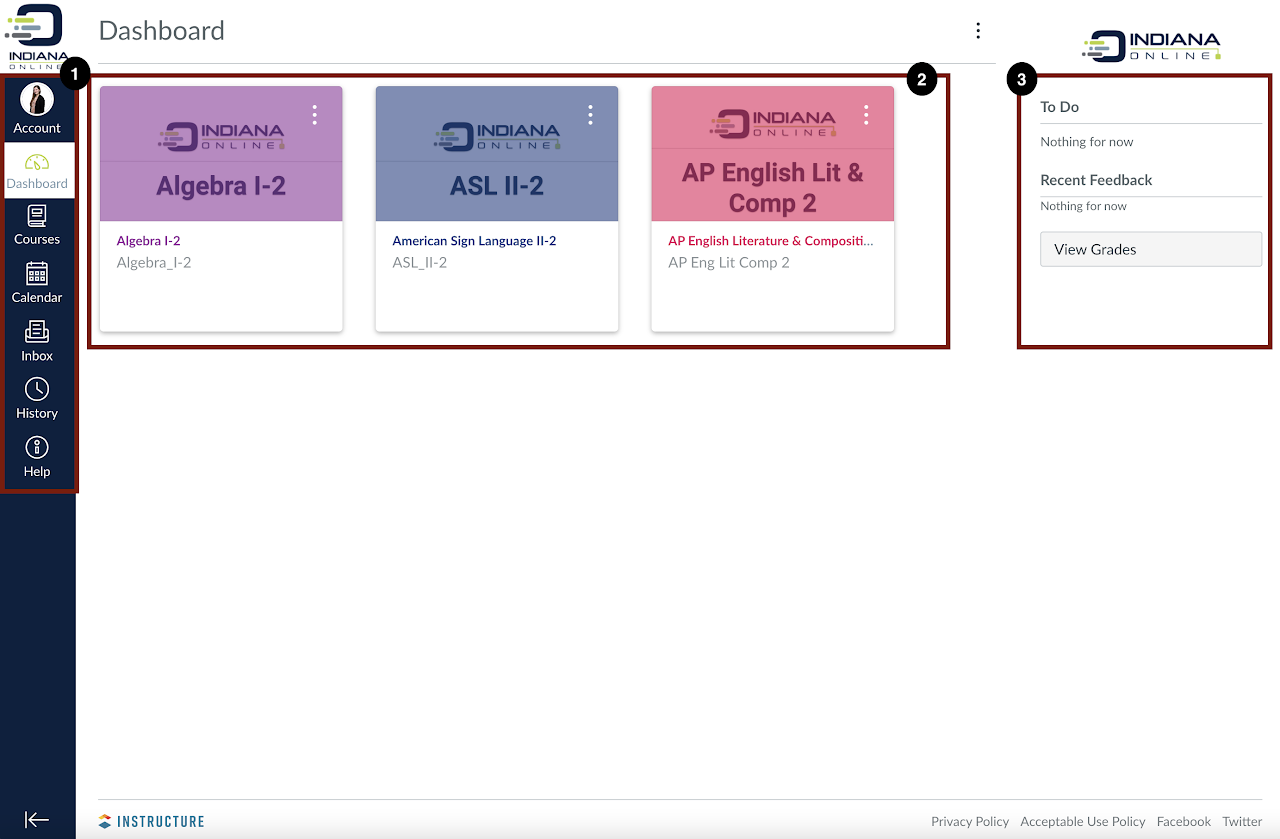
The Dashboard is the first thing you will see when you log into Canvas. Everything is at your fingertips from here. Things you’ll see on your Dashboard include:
- Global Navigation Menu: You can return to your User Dashboard at any time by clicking the Dashboard link in the Global Navigation Menu.
- Course Cards: All current courses represented by tiles
- Sidebar
-
- To Do List: Students see a list of up to 25 items they need to do in their courses. Each is a link into the actual course.
- Recent Feedback: Items that contain feedback from your teacher
- View Grades: A quick link to your grades
- Coming Up: Look ahead into your Canvas Calendar, showing events and assessments due today and going forward 7 days
Not pictured, Global Announcements: If we have Indiana Online global announcements to push out
Here are some ideas about how you can extend your use of the Dashboard:
- Give Course Nicknames: Each Course Tile will show you the official name of the course. We have assigned our official Indiana Online course name, but a Course Nickname can assist you to keep track of the courses you choose to keep visible and organized on your dashboard.
- Change the color of your Course card: Click the three vertical dots (that’s called a kabob selector!) and you’ll see a pallet of colors. Whatever color you pick is just for you. Every user can customize his or her own dashboard colors. Colors are important and also will represent that course in your Calendar. (Need more colors? Check out color-hex to find just the right color for your course!)
- Remove the Color Overlay: Super important if you’re using images in your Course cards and you don’t want it to look “hazy” because the color is overlaying it. Click the three vertical dots on your Dashboard screen and unselect “Color Overlay”
- Change the Dashboard View: Select how you want to see your course whether as a card view, list view or recent activity
Canvas Community Resources - Documentation
Modules
Indiana Online uses modules to organize the course. Modules control the entire flow of the course, along with its content, and are organized by order of progression. You can access Modules by clicking on Modules in the course navigation or the Modules button on the Course Home Page.

View Modules
To expand or collapse individual modules, click the module Expand or Collapse arrows [1]. To expand or collapse all modules, click the Expand All/Collapse All button [2].
Module Requirements
All Indiana Online modules must be completed in order. You can skip around within the module, but you must complete all tasks in the module before you can progress to the next module. A module may require a prerequisite [1].
Next to the module item, you can view the type of requirement necessary to complete the module item [2].
Depending on the module item type, requirements include up to five options:
- View: You must view the item.
- Mark as done: You must mark the module item as done before you can progress to the next item.
- Contribute: You must post a reply to the discussion topic or contribute content to a page.
- Submit: You must submit the assignment, graded discussion, or quiz.
- Score at least X: You must submit the assignment with a minimum of the shown score.

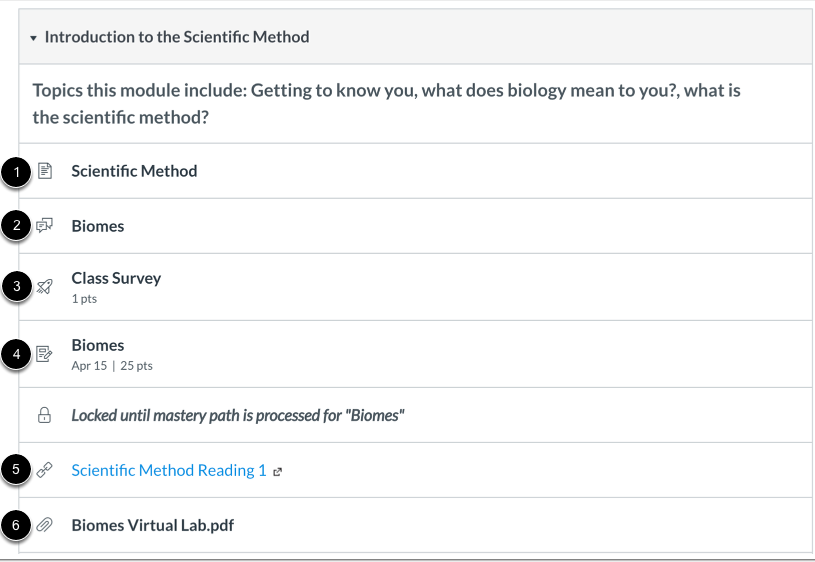
Module Content
Modules can be filled with different types of content. Each module item also includes an icon with its type:
- Page [1]: a page of content to read
- Discussion [2]: a course discussion
- Quiz [3]: a course quiz
- Assignment [4]: a course assignment
- Link or External Tool [5]: an external link or tool to view outside of the course
- File [6]: a file to download or view
Module Progression
Module items can also be used to show progression through a module. Modules and/or module items that are not available to you are grayed out.
For any module icon, you can hover over the icon and view the message for the requirement.
Icon meanings may change depending on if your course is using requirements:
- Orange dash icon [1]: when next to a module item, the module item is overdue. When next to the module heading, the module requirements have not been met.
- Green check mark [2]: the module item has been completed. For requirements, this icon means the module requirement has been met.
- Blue info icon [3]: the module item has been submitted, but has not yet been graded.
- Options label [4]: the module item requires you to choose an assignment path before additional module items can be displayed.
- White circle [5]: the module item has not been started.
- Lock icon [6]: the module is locked until a future date. For prerequisites, this icon means the previous module has not been completed so it cannot be viewed.
- Lock message [7]: the module may contain additional information that cannot be accessed until the name of the assignment in the message is graded.


Module Item
Each module contains a variety of items. Each item includes the item name [1], which can be clicked to open and view additional details. Items will display the due date (if any) [2], and the number of points the assignment is worth [3]. If a requirement exists, the type of requirement will be the last piece [4].
Module Navigation
You can advance through the module or return to previous modules using the progression bar at the bottom of the page. To advance to the next module item, click the Next button [1]. To return to a previous module item, click the Previous button [2].
You can view the name of the next or previous module item by hovering over the Next or Previous button, respectively.

Assignments
Assignments are denoted by a notebook and pencil icon. Not all courses will have assignments.

Open an Assignment
Assignments are denoted by a notebook and pencil icon. Not all courses will have assignments.

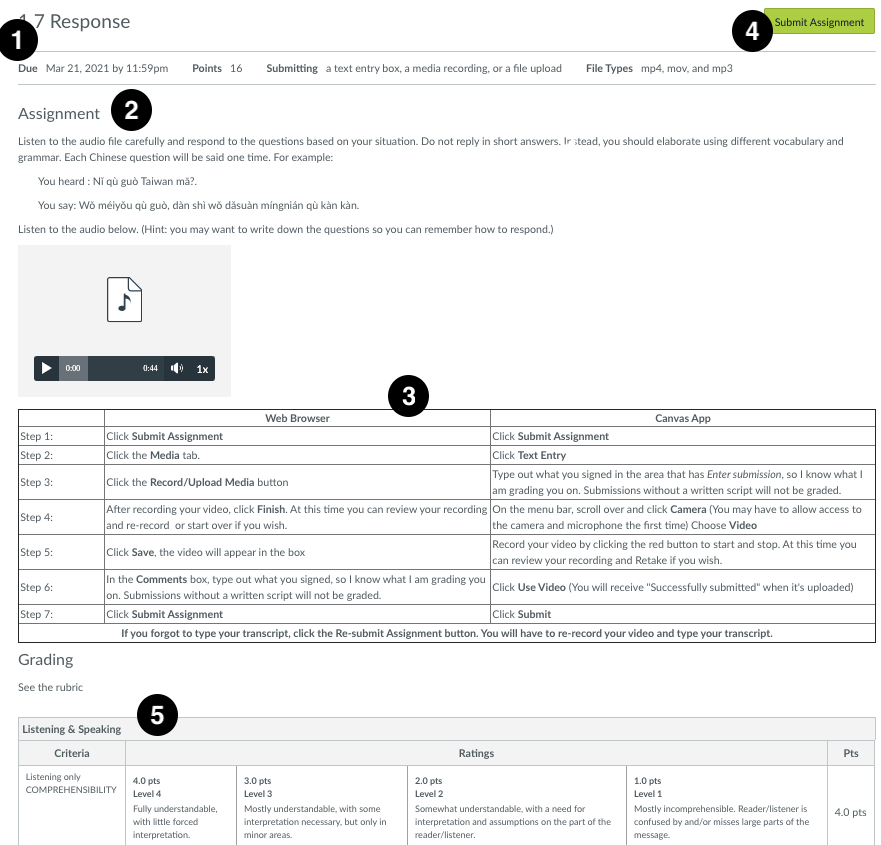
View Assignment Details
After opening an assignment, you can view additional details:
- Assignment details, such as the due date, points, submission options, and the type(s) of submission(s) you can use for the assignment [1].
- Attempts and Allowed Attempts may also be viewed, if applicable
- Instructions [2]: any instructions that your teacher has about the assignment. Please note that you cannot download assignment instructions unless your teacher has included a link to download them. You can also print the screen or copy and paste the directions into a word processing program, or you can also view the assignment in the Canvas mobile app.
- Steps for submission [3] (more info from Canvas: submit your assignment).
- Submit Assignment link [4].
- Rubric [5]: any grading criteria that your teacher has provided for the assignment. An assignment may or may not include a rubric.
If you were to miss the due date, you could still submit the assignment for full credit.
Submit Assignments
You can submit online assignments in Canvas using several submission types, which are detailed in the specific assignment. You may also have the option to resubmit assignments.
Any attachments added as part of a graded assignment submission are also copied to your user files but are not counted against your user quota. However, once the file has been uploaded as a submission, you cannot delete the file.

To upload a file from your computer and submit it as your assignment, select the File Upload tab.

To submit a text entry assignment, select the Text Entry tab.

To submit a media recording, select the Media tab.
Discussions
A discussion is denoted by two speech bubbles. Not all courses have discussions.

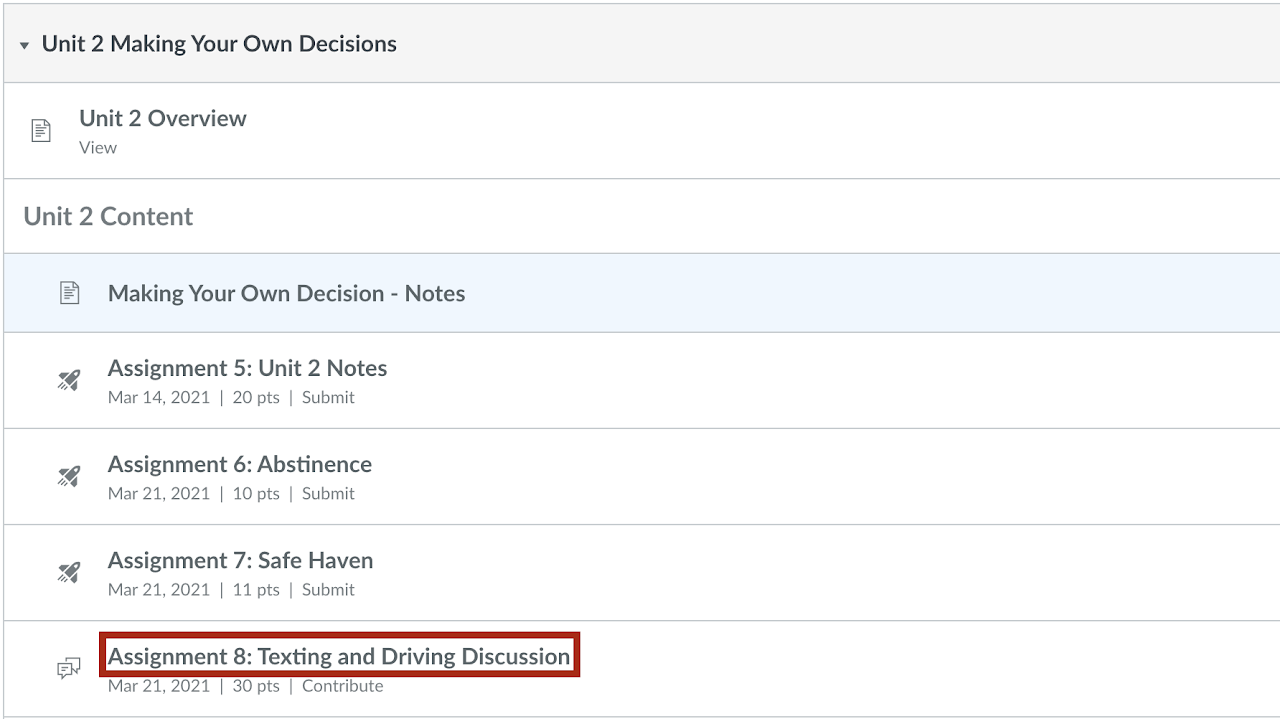
Open a Discussion
Discussions can be accessed through Modules, the Syllabus, Gradebook, Calendar, and the To Do on the course home page or dashboard. Discussions are also listed on the Indiana Online Pacing Guide.
To open a discussion, click on the title of the discussion in the module.
View a Discussion
Once in a discussion, you have several options to view and sort posts and replies. Use the search field [1] to search for replies or specific authors. To filter by unread replies, click the Unread button [2]. You can also collapse and expand [3] all discussion replies.
To subscribe to a discussion, click the subscribe button [4]. Subscribing to a discussion allows you to follow the discussion and receive notifications as set in your notification preferences. You are automatically subscribed to any discussions you reply to. If you are subscribed, the button will have a green background. In you would like to unsubscribe, click the Subscribe button and the background will turn gray.
To open options for the discussion, click the Options button [5]. Options allows you to mark all existing posts (replies) as read. If your discussion is graded against a rubric, you can view the rubric by selecting the Options button.
You can view how many unread and replies are in a thread [6]. The number on the left indicates unread replies, while the number on the right indicates the total number of replies.
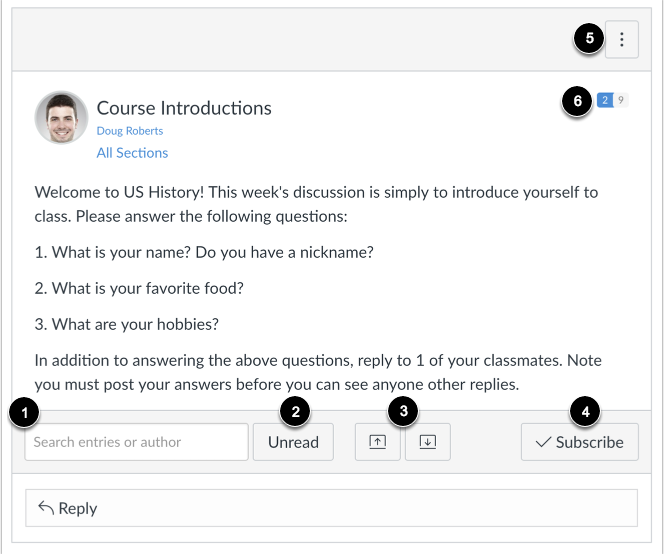
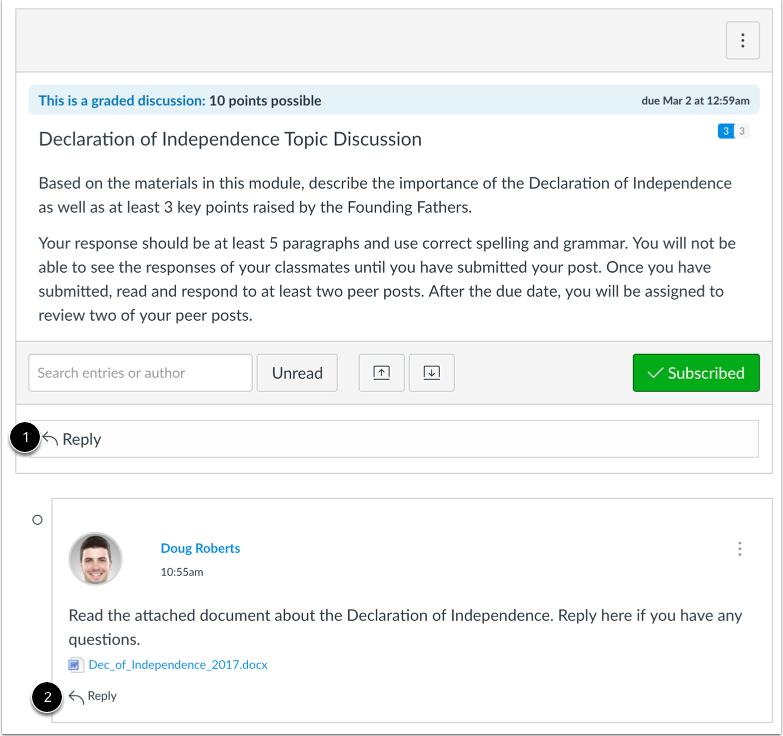
Reply to a Discussion
To reply to the main discussion topic, click the Reply field [1]. If your discussion is threaded, you can reply to any other post in the discussion by clicking the Reply link [2].
Your reply will be posted at the bottom of the discussion reply thread. The border of your post will flash indicating it has been newly posted. A green dot will show next to unread replies.
Post a Message
Write your response in the Rich Content Editor space [1]. You can add links, photos, equations, and/or media. You can also attach files [2]. Once you finish with your post, click the Post Reply button [3] to submit your work.
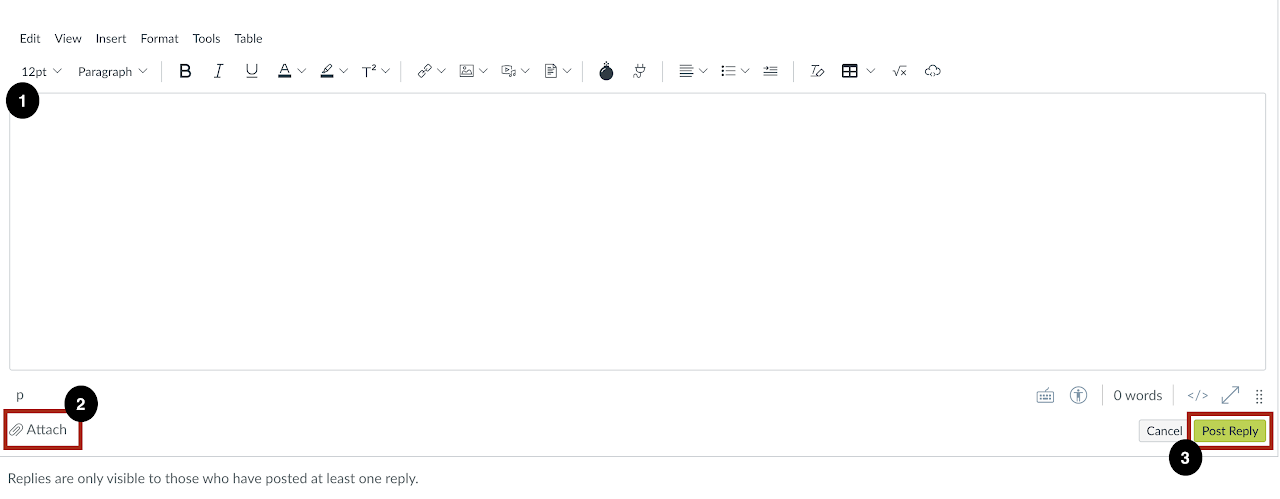

Reply to a Post
You can reply to a comment already posted by another student by clicking in the reply field below the post and then posting a message.
Quizzes
A quiz or test is denoted by the rocket ship icon. Quizzes will be found throughout your course.


Quiz or Test
Quizzes and tests can be accessed through Modules, the Syllabus, Gradebook, Calendar, and the To Do on the course home page or dashboard. Quizzes and tests are also listed on the Indiana Online Pacing Guide.
To complete a quiz or test, you must click on the title of the quiz or test in the module.
View a Quiz or Test
After opening a quiz or test, you can view additional details:
- The due date for the quiz [1].
- Points available [2].
- The number of questions for the quiz or test [3].
- Time Limit [4]: the length of time you have to complete the quiz. If your quiz has a time limit, you must complete the entire quiz within that time in one sitting. If you navigate away from the quiz, the timer will keep running. You will also be kicked out of the quiz when the time limit has been reached.
- Allowed attempts for the quiz or test [5].
- Instructions [6]: any instructions that your teacher has about the quiz.
- Access to take the quiz [7].
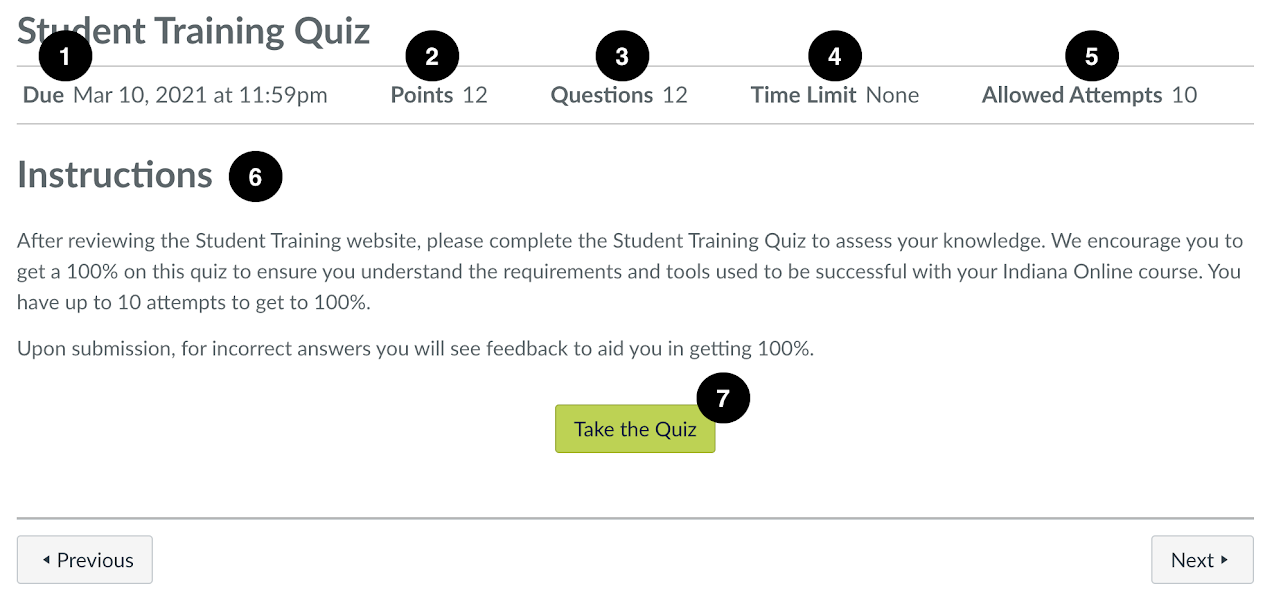

Progress of a Quiz or Test
At any point during the quiz, you can view a summary of your quiz. Questions you’ve answered will be green and identified by a checkmark icon [1], the current question will be bolded while on it and turn to blue with a checkmark icon when answered [2], and unanswered questions will be identified by a question mark icon [3].
You can view the details of the quiz [4] and you will also see a timer showing your progress on the quiz [5]. For untimed quizzes, the quiz shows as the elapsed time. If you are taking a timed quiz, the timer shows the running time and counts down until time expires.
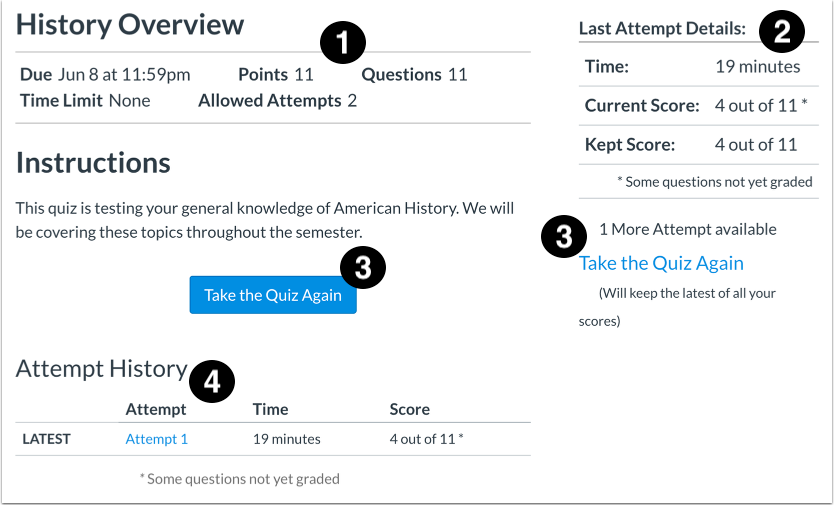
View the Results
Quiz results are easy to read in Canvas. Upon completion, you will see:
- Details of the Quiz or Test [1].
- Last Attempt Details, include time it took to complete the quiz or test, Current Score, and Kept Score (the score that Canvas records in the Gradebook) [2].
- If allowed, you can take the quiz again by selecting the link in the Last Attempt Details or by clicking on the Take the Quiz Again button [3].
- Attempt History [4] shows your latest quiz attempt, the time it took to take the quiz, and your score.
Review Grades
This video will inform you how to check your grades:
Teacher Feedback
There are multiple ways to review feedback from your teacher. The video provided demonstrates how to check for feedback by selecting Grades in your course navigation. Additionally, you can view feedback directly on your dashboard under Recent Feedback.
Ensure you are clicking on the thought bubble to review specific feedback comments.
Zeros "0" and Ones "1" in the Grade Book
The submission of a blank document or unanswered quiz to raise your completion percentage will result in no grade being entered in the grade book.
As the course progresses, a zero “0” will be entered for any assignments that you did not complete or submit by the due date.
A one “1” will be entered in the grade book if a completed assignment is submitted, but no points were earned.
Video Conferences
At times during your course, you will have the opportunity to attend a live online course meeting with your teacher. The purpose of the meeting is for you to connect with your teacher, get assistance, and/or ask questions. Most likely, your teacher will post a link to a Zoom meeting in an announcement.
Basic System Requirements
To ensure the best experience possible, please follow the requirements and recommendations provided.
Browser
You do not need to download Zoom software. We recommend using Zoom in your browser. The supported browser at Indiana Online is Chrome. When using Zoom, you must be using Chrome for full functionality (please note that other browsers may support some functionality, but Chrome supports full functionality). Your Internet browser must be up-to-date (installed or updated within the last month). Read the directions on how to update Chrome if you aren’t sure how to do this.
Internet
As a general rule, the better your internet connection, the better experience you will have. If your connection is unstable/below the speeds recommended, then use a wired connection or a stable wireless connection while uploading/recording.
If you want to check your network speed independently of a conference, you can check:
Device
Recommended Devices
You must have a webcam and microphone working with your computer (most are built-in). If you do not have a built-in webcam/mic, they can be purchased and plugged into your computer.
To find your mic/webcam settings, review your computer documentation.
- Mac/PC
- Desktop/Laptop
- Chromebook
Supported Devices
On a mobile device, you can access the shared Zoom link in Canvas through a browser or the Zoom app. The Zoom app can be found in your device’s app store.
Joining a Conference
There are multiple ways to potentially receive a link for a conference:
- Your teacher will post a link in the Announcements for a general course meeting
- Your teacher will email or send to you directly a link
- In the Zoom Meeting tab in your Canvas course, you will find a link to the meeting
**The example provided show the link posted in the Announcements.

Enable Your Camera and Microphone
After you have entered your meeting a pop-up will display to enable your microphone and camera. Click ‘Ok’ or ‘Allow’ depending on your device.
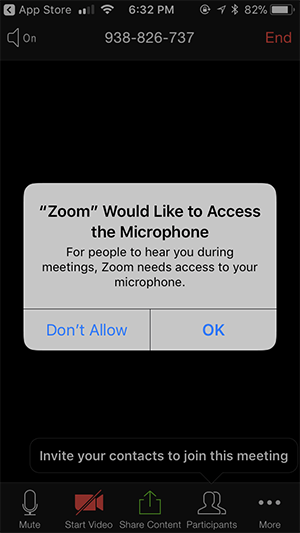
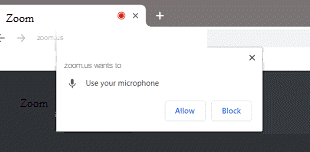
Waiting Room
You will remain in a “waiting room” until your teacher admits you to your Zoom meeting.
When joining a meeting select your preferred method of audio:
- Wifi will provide audio using your internet service
- Dial in audio allows you to call in on your mobile device
- Do not use audio should only be selected if you only plan to listen
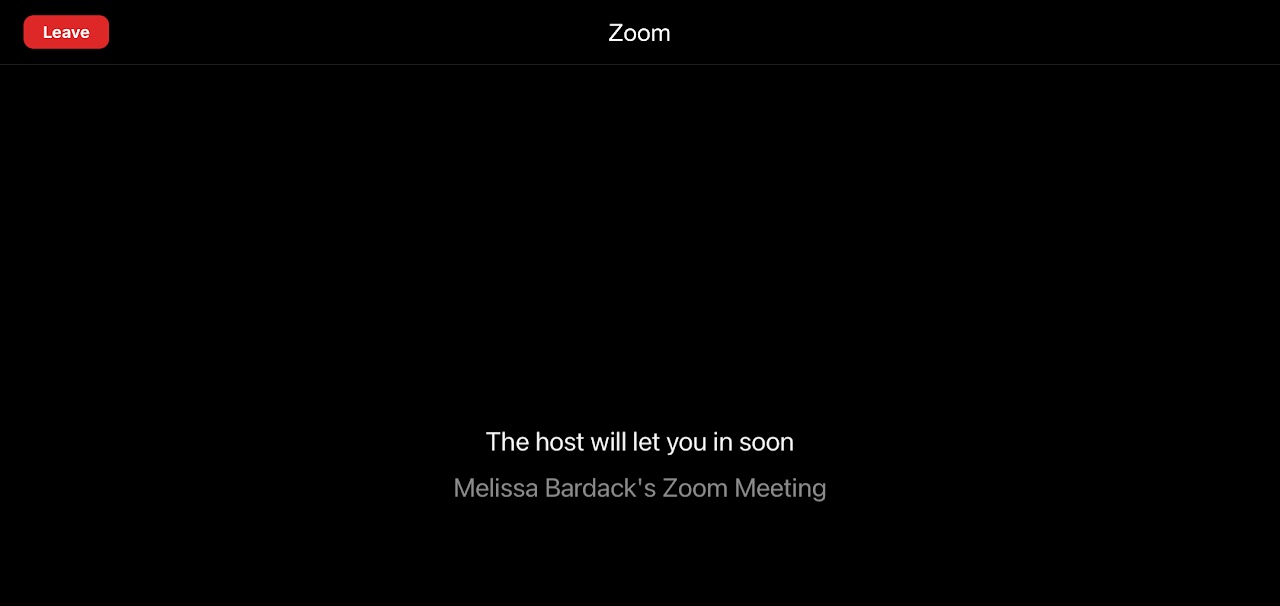
Settings
Will you speak or listen only? What about turn on or off your camera? You will need to select the appropriate settings.

Video Settings
Click to turn your camera on/off. If you cannot see yourself, click on the ^ icon and select your device.
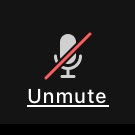
Audio Settings
Click to turn on/off your microphone. Click the ^ icon to select a microphone from your device.
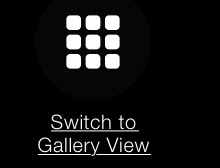
View Options
Click the View grid to view more or less participants during the Zoom meeting.

Public Chat
If you have ever used a virtual meeting program, there is always an area for participants to chat. Click the message icon to display and join the Chat.

Share Content
You may also participate in the meeting by Sharing Your Screen, if enabled by your teacher.

Additional Settings
You may make additional adjustments to your Zoom settings by clicking the More menu.
Contact your teacher if you have any questions!
Please note that Indiana Online cannot troubleshoot hardware issues on your device. We can only help with basic troubleshooting.
Word & Google
Many assignments will have a document to complete. If the only document in there is a Microsoft Word file and you don’t have Word, what can you do? Or your Gmail account is through your school and you can’t access the Google Doc? You will need to have a personal Gmail account. (Make sure you have parental permission to create an account.) Gmail accounts have a suite of products that are comparable to Microsoft.
Converting Google Docs to Microsoft Word or PDF
Now that you have completed the assignment, you need to submit it to your assignment. Unfortunately, you can’t submit a link to the assignment. It requires an actual file. You have to convert the Google Doc to either Microsoft Word or PDF:
- Go to File
- Select Download as
- Click Microsoft Word (.docx) or PDF document (.pdf)
Now you will be able to upload your completed assignment.
Converting Microsoft Word to Google Docs
If the only file available is Microsoft Word, you can still access it with Google:
- Download the Word file
- Drag the file to your Google Drive
- Do a right mouse click on the file
- Select Open with
- Click Google Docs
Now you will be able to type on the document. Make changes to the Google Doc as directed by your teacher. Your changes are saved automatically as you make them.
Gmail Account Through School
If your Gmail account is through school, your school may have blocked you from viewing documents outside your school’s domain. Many assignments will have a Google Doc file. When you click on the file, you should be asked to create a copy of the file automatically. If you get the message that you need access to the file, your school account has blocked you from accessing the document. There are two ways to complete the assignment:
- Follow the directions above on converting the Microsoft Word file.
- If you like working in Google, you will need a personal Gmail account. (Ensure you have parental permission before you create your account.)
If you have a personal Gmail account, then you will be able to get the copy of the assignment. You will still have to convert the file to a Microsoft Word or PDF file when you are done, though, in order to submit the assignment.
Canvas App
The Canvas Student App allows students to access their courses and groups using a mobile device. Students can view and submit assignments, view and participate in discussions, view grades, and view course materials and user files. The app also provides access to course calendars, To Do items, notifications, and messages via the Inbox. Students can access their courses and groups from the Dashboard. Courses and groups include the navigation items that can be viewed in the browser version of Canvas.
Canvas Student requires a Canvas account and is available for both Android and iOS devices.
To access Canvas App, you will need to use a different device to first log into Genius, then Launch your course. Once you’re in Canvas, you can go under your profile and scan the QR Code for the mobile app. Scan the code with your iPad, Phone, or tablet, and then you’re logged in on the app. You have 10 minutes to use the code before it expires.
Note: Not all Canvas features are supported on the app at this time and Indiana Online recommends accessing Canvas via a web browser on a laptop or computer.
Observer in Canvas
Visit indianaonline.instructure.com/login/canvas to get started.
Parents/guardians can sign up as an observer in Canvas. Observers can link their Canvas account to their student’s account so they can see assignment dues dates, announcements, and other course content, such as the pacing guide to track student course completion. Observers can view the course content but cannot participate in the course.
In order to create a Canvas account, you will need to visit the Indiana Online Canvas instance and select “Parent of a Canvas User? Click Here For an Account”. Please ensure you are using a separate email from your student.
During the registration process, you will need your student’s pairing code, which your student can generate for you. A separate pairing code is needed for each observer, and a student can have up to five different observers. The pairing code is case sensitive, and it will expire after seven days of its first use.
Additional details can be found at the Canvas FAQ on Pairing Codes.
Once you have an account, you can add additional students for observation and you are able to view student information through the Canvas Parent app.
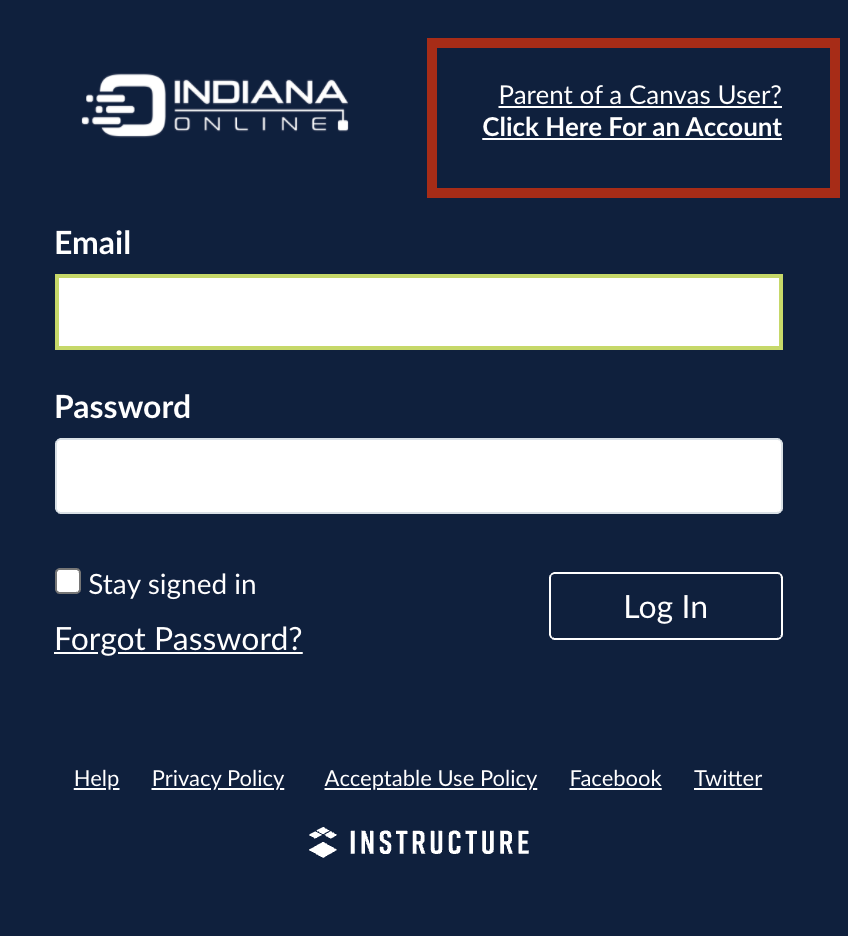
Observers can:
- View and read announcements
- View assignments index page
- View the calendar
- Join conferences, if invited
- Join collaborations, if invited
- View personal inbox
- Send conversation messages to teacher and student they are observing
- View the dashboard
- View and read discussions
- View files unless they are locked
- View grades, view assignment due dates and comments, and print grades
- View modules and see due dates and point values
- View pages and contribute if the teacher enables the Anyone can edit it setting
- View profile pictures, if available
- View syllabus
- View outcomes
- View quizzes index page
Observers cannot:
- Comment on announcements or discussions
- Submit assignments or quizzes
- View course rosters
- Send conversation messages to students in the course they are not observing
- View locked files or folders
- Join groups
- View unpublished courses
- Access the Chat tool
- Reserve appointment slots in the Scheduler
- View grade audit trail
Check Release Conditions
If you are not able to progress in the course, ensure all release conditions for the module have been met.
Submit a Help Ticket
You have the ability to submit a support ticket from the Indiana Online webpage and from a link within your course. The support ticket system has a “Knowledge Base” that will answer many of the common questions that students and parents have concerning the Indiana Online program and our courses. Part of being a great online student is the ability to use the tools and resources you have to find answers and/or solutions. The Knowledge Base is provided to answer most questions. Please take advantage of it as much as possible.
Sometimes you may have a question that you cannot find a solution for in the Knowledge Base. Use the items below to help you determine your next step.
Items not requiring a help ticket (contact your teacher):
- Course content related questions
- Instructional assistance
- Grade related questions
Submit a help ticket for questions concerning:
- Questions concerning Indiana Online Policies
- Any technical glitches in the course (content not showing up or a bad link)
Watch this video to learn how to submit a help ticket. Remember, the more information you provide (name, course, browser, device, specific issue including title of item and location in the course) the better service we will be able to provide you.
Canvas Student Guides
The Canvas Student Guide has over 200 lessons that each answer a question that relates to using the Canvas interface as a student.
- Student Canvas Orientation
-
- Profile & Dashboard
-
Setting Your Profile and Notification Preferences
You are able to change your profile picture which can be viewed by all users in your course. Please select an appropriate and professional image.
- Select Account/Settings in order to change your profile image
Additionally, it is important that you set your notification preferences to receive important course information. You can set the notifications to your specific, individual preference, such as notify immediately, daily summary, weekly summary or notifications off.
- Select Account/Notifications in order to set your preferences
- At a minimum, we recommend “notify immediately” for
- Due Date
- Announcement
- Grading
Canvas Dashboard

The Dashboard is the first thing you will see when you log into Canvas. Everything is at your fingertips from here. Things you’ll see on your Dashboard include:
- Global Navigation Menu: You can return to your User Dashboard at any time by clicking the Dashboard link in the Global Navigation Menu.
- Course Cards: All current courses represented by tiles
- Sidebar
-
- To Do List: Students see a list of up to 25 items they need to do in their courses. Each is a link into the actual course.
- Recent Feedback: Items that contain feedback from your teacher
- View Grades: A quick link to your grades
- Coming Up: Look ahead into your Canvas Calendar, showing events and assessments due today and going forward 7 days
Not pictured, Global Announcements: If we have Indiana Online global announcements to push out
Here are some ideas about how you can extend your use of the Dashboard:
- Give Course Nicknames: Each Course Tile will show you the official name of the course. We have assigned our official Indiana Online course name, but a Course Nickname can assist you to keep track of the courses you choose to keep visible and organized on your dashboard.
- Change the color of your Course card: Click the three vertical dots (that’s called a kabob selector!) and you’ll see a pallet of colors. Whatever color you pick is just for you. Every user can customize his or her own dashboard colors. Colors are important and also will represent that course in your Calendar. (Need more colors? Check out color-hex to find just the right color for your course!)
- Remove the Color Overlay: Super important if you’re using images in your Course cards and you don’t want it to look “hazy” because the color is overlaying it. Click the three vertical dots on your Dashboard screen and unselect “Color Overlay”
- Change the Dashboard View: Select how you want to see your course whether as a card view, list view or recent activity
Canvas Community Resources - Documentation
- Modules
-
Modules
Indiana Online uses modules to organize the course. Modules control the entire flow of the course, along with its content, and are organized by order of progression. You can access Modules by clicking on Modules in the course navigation or the Modules button on the Course Home Page.

View Modules
To expand or collapse individual modules, click the module Expand or Collapse arrows [1]. To expand or collapse all modules, click the Expand All/Collapse All button [2].
Module Requirements
All Indiana Online modules must be completed in order. You can skip around within the module, but you must complete all tasks in the module before you can progress to the next module. A module may require a prerequisite [1].
Next to the module item, you can view the type of requirement necessary to complete the module item [2].
Depending on the module item type, requirements include up to five options:
- View: You must view the item.
- Mark as done: You must mark the module item as done before you can progress to the next item.
- Contribute: You must post a reply to the discussion topic or contribute content to a page.
- Submit: You must submit the assignment, graded discussion, or quiz.
- Score at least X: You must submit the assignment with a minimum of the shown score.


Module Content
Modules can be filled with different types of content. Each module item also includes an icon with its type:
- Page [1]: a page of content to read
- Discussion [2]: a course discussion
- Quiz [3]: a course quiz
- Assignment [4]: a course assignment
- Link or External Tool [5]: an external link or tool to view outside of the course
- File [6]: a file to download or view
Module Progression
Module items can also be used to show progression through a module. Modules and/or module items that are not available to you are grayed out.
For any module icon, you can hover over the icon and view the message for the requirement.
Icon meanings may change depending on if your course is using requirements:
- Orange dash icon [1]: when next to a module item, the module item is overdue. When next to the module heading, the module requirements have not been met.
- Green check mark [2]: the module item has been completed. For requirements, this icon means the module requirement has been met.
- Blue info icon [3]: the module item has been submitted, but has not yet been graded.
- Options label [4]: the module item requires you to choose an assignment path before additional module items can be displayed.
- White circle [5]: the module item has not been started.
- Lock icon [6]: the module is locked until a future date. For prerequisites, this icon means the previous module has not been completed so it cannot be viewed.
- Lock message [7]: the module may contain additional information that cannot be accessed until the name of the assignment in the message is graded.


Module Item
Each module contains a variety of items. Each item includes the item name [1], which can be clicked to open and view additional details. Items will display the due date (if any) [2], and the number of points the assignment is worth [3]. If a requirement exists, the type of requirement will be the last piece [4].
Module Navigation
You can advance through the module or return to previous modules using the progression bar at the bottom of the page. To advance to the next module item, click the Next button [1]. To return to a previous module item, click the Previous button [2].
You can view the name of the next or previous module item by hovering over the Next or Previous button, respectively.

- Assignments
-
Assignments
Assignments are denoted by a notebook and pencil icon. Not all courses will have assignments.

Open an Assignment
Assignments are denoted by a notebook and pencil icon. Not all courses will have assignments.


View Assignment Details
After opening an assignment, you can view additional details:
- Assignment details, such as the due date, points, submission options, and the type(s) of submission(s) you can use for the assignment [1].
- Attempts and Allowed Attempts may also be viewed, if applicable
- Instructions [2]: any instructions that your teacher has about the assignment. Please note that you cannot download assignment instructions unless your teacher has included a link to download them. You can also print the screen or copy and paste the directions into a word processing program, or you can also view the assignment in the Canvas mobile app.
- Steps for submission [3] (more info from Canvas: submit your assignment).
- Submit Assignment link [4].
- Rubric [5]: any grading criteria that your teacher has provided for the assignment. An assignment may or may not include a rubric.
If you were to miss the due date, you could still submit the assignment for full credit.
Submit Assignments
You can submit online assignments in Canvas using several submission types, which are detailed in the specific assignment. You may also have the option to resubmit assignments.
Any attachments added as part of a graded assignment submission are also copied to your user files but are not counted against your user quota. However, once the file has been uploaded as a submission, you cannot delete the file.

To upload a file from your computer and submit it as your assignment, select the File Upload tab.

To submit a text entry assignment, select the Text Entry tab.

To submit a media recording, select the Media tab.
- Assignment details, such as the due date, points, submission options, and the type(s) of submission(s) you can use for the assignment [1].
- Discussions
-
Discussions
A discussion is denoted by two speech bubbles. Not all courses have discussions.


Open a Discussion
Discussions can be accessed through Modules, the Syllabus, Gradebook, Calendar, and the To Do on the course home page or dashboard. Discussions are also listed on the Indiana Online Pacing Guide.
To open a discussion, click on the title of the discussion in the module.
View a Discussion
Once in a discussion, you have several options to view and sort posts and replies. Use the search field [1] to search for replies or specific authors. To filter by unread replies, click the Unread button [2]. You can also collapse and expand [3] all discussion replies.
To subscribe to a discussion, click the subscribe button [4]. Subscribing to a discussion allows you to follow the discussion and receive notifications as set in your notification preferences. You are automatically subscribed to any discussions you reply to. If you are subscribed, the button will have a green background. In you would like to unsubscribe, click the Subscribe button and the background will turn gray.
To open options for the discussion, click the Options button [5]. Options allows you to mark all existing posts (replies) as read. If your discussion is graded against a rubric, you can view the rubric by selecting the Options button.
You can view how many unread and replies are in a thread [6]. The number on the left indicates unread replies, while the number on the right indicates the total number of replies.


Reply to a Discussion
To reply to the main discussion topic, click the Reply field [1]. If your discussion is threaded, you can reply to any other post in the discussion by clicking the Reply link [2].
Your reply will be posted at the bottom of the discussion reply thread. The border of your post will flash indicating it has been newly posted. A green dot will show next to unread replies.
Post a Message
Write your response in the Rich Content Editor space [1]. You can add links, photos, equations, and/or media. You can also attach files [2]. Once you finish with your post, click the Post Reply button [3] to submit your work.


Reply to a Post
You can reply to a comment already posted by another student by clicking in the reply field below the post and then posting a message.
- Quizzes
-
Quizzes
A quiz or test is denoted by the rocket ship icon. Quizzes will be found throughout your course.


Quiz or Test
Quizzes and tests can be accessed through Modules, the Syllabus, Gradebook, Calendar, and the To Do on the course home page or dashboard. Quizzes and tests are also listed on the Indiana Online Pacing Guide.
To complete a quiz or test, you must click on the title of the quiz or test in the module.
View a Quiz or Test
After opening a quiz or test, you can view additional details:
- The due date for the quiz [1].
- Points available [2].
- The number of questions for the quiz or test [3].
- Time Limit [4]: the length of time you have to complete the quiz. If your quiz has a time limit, you must complete the entire quiz within that time in one sitting. If you navigate away from the quiz, the timer will keep running. You will also be kicked out of the quiz when the time limit has been reached.
- Allowed attempts for the quiz or test [5].
- Instructions [6]: any instructions that your teacher has about the quiz.
- Access to take the quiz [7].


Progress of a Quiz or Test
At any point during the quiz, you can view a summary of your quiz. Questions you’ve answered will be green and identified by a checkmark icon [1], the current question will be bolded while on it and turn to blue with a checkmark icon when answered [2], and unanswered questions will be identified by a question mark icon [3].
You can view the details of the quiz [4] and you will also see a timer showing your progress on the quiz [5]. For untimed quizzes, the quiz shows as the elapsed time. If you are taking a timed quiz, the timer shows the running time and counts down until time expires.

View the Results
Quiz results are easy to read in Canvas. Upon completion, you will see:
- Details of the Quiz or Test [1].
- Last Attempt Details, include time it took to complete the quiz or test, Current Score, and Kept Score (the score that Canvas records in the Gradebook) [2].
- If allowed, you can take the quiz again by selecting the link in the Last Attempt Details or by clicking on the Take the Quiz Again button [3].
- Attempt History [4] shows your latest quiz attempt, the time it took to take the quiz, and your score.
- Grades
-
Review Grades
This video will inform you how to check your grades:
Teacher Feedback
There are multiple ways to review feedback from your teacher. The video provided demonstrates how to check for feedback by selecting Grades in your course navigation. Additionally, you can view feedback directly on your dashboard under Recent Feedback.
Ensure you are clicking on the thought bubble to review specific feedback comments.
Zeros "0" and Ones "1" in the Grade Book
The submission of a blank document or unanswered quiz to raise your completion percentage will result in no grade being entered in the grade book.
As the course progresses, a zero “0” will be entered for any assignments that you did not complete or submit by the due date.
A one “1” will be entered in the grade book if a completed assignment is submitted, but no points were earned.
- Video Conferences
-
Video Conferences
At times during your course, you will have the opportunity to attend a live online course meeting with your teacher. The purpose of the meeting is for you to connect with your teacher, get assistance, and/or ask questions. Most likely, your teacher will post a link to a Zoom meeting in an announcement.
Basic System Requirements
To ensure the best experience possible, please follow the requirements and recommendations provided.
Browser
You do not need to download Zoom software. We recommend using Zoom in your browser. The supported browser at Indiana Online is Chrome. When using Zoom, you must be using Chrome for full functionality (please note that other browsers may support some functionality, but Chrome supports full functionality). Your Internet browser must be up-to-date (installed or updated within the last month). Read the directions on how to update Chrome if you aren’t sure how to do this.
Internet
As a general rule, the better your internet connection, the better experience you will have. If your connection is unstable/below the speeds recommended, then use a wired connection or a stable wireless connection while uploading/recording.
If you want to check your network speed independently of a conference, you can check:
Device
Recommended Devices
You must have a webcam and microphone working with your computer (most are built-in). If you do not have a built-in webcam/mic, they can be purchased and plugged into your computer.
To find your mic/webcam settings, review your computer documentation.
- Mac/PC
- Desktop/Laptop
- Chromebook
Supported Devices
On a mobile device, you can access the shared Zoom link in Canvas through a browser or the Zoom app. The Zoom app can be found in your device’s app store.
Joining a Conference
There are multiple ways to potentially receive a link for a conference:
- Your teacher will post a link in the Announcements for a general course meeting
- Your teacher will email or send to you directly a link
- In the Zoom Meeting tab in your Canvas course, you will find a link to the meeting
**The example provided show the link posted in the Announcements.

Enable Your Camera and Microphone
After you have entered your meeting a pop-up will display to enable your microphone and camera. Click ‘Ok’ or ‘Allow’ depending on your device.


Waiting Room
You will remain in a “waiting room” until your teacher admits you to your Zoom meeting.
When joining a meeting select your preferred method of audio:
- Wifi will provide audio using your internet service
- Dial in audio allows you to call in on your mobile device
- Do not use audio should only be selected if you only plan to listen

Settings
Will you speak or listen only? What about turn on or off your camera? You will need to select the appropriate settings.

Video Settings
Click to turn your camera on/off. If you cannot see yourself, click on the ^ icon and select your device.

Audio Settings
Click to turn on/off your microphone. Click the ^ icon to select a microphone from your device.

View Options
Click the View grid to view more or less participants during the Zoom meeting.

Public Chat
If you have ever used a virtual meeting program, there is always an area for participants to chat. Click the message icon to display and join the Chat.

Share Content
You may also participate in the meeting by Sharing Your Screen, if enabled by your teacher.

Additional Settings
You may make additional adjustments to your Zoom settings by clicking the More menu.
Contact your teacher if you have any questions!
Please note that Indiana Online cannot troubleshoot hardware issues on your device. We can only help with basic troubleshooting.
- Word & Google
-
Word & Google
Many assignments will have a document to complete. If the only document in there is a Microsoft Word file and you don’t have Word, what can you do? Or your Gmail account is through your school and you can’t access the Google Doc? You will need to have a personal Gmail account. (Make sure you have parental permission to create an account.) Gmail accounts have a suite of products that are comparable to Microsoft.
Converting Google Docs to Microsoft Word or PDF
Now that you have completed the assignment, you need to submit it to your assignment. Unfortunately, you can’t submit a link to the assignment. It requires an actual file. You have to convert the Google Doc to either Microsoft Word or PDF:
- Go to File
- Select Download as
- Click Microsoft Word (.docx) or PDF document (.pdf)
Now you will be able to upload your completed assignment.
Converting Microsoft Word to Google Docs
If the only file available is Microsoft Word, you can still access it with Google:
- Download the Word file
- Drag the file to your Google Drive
- Do a right mouse click on the file
- Select Open with
- Click Google Docs
Now you will be able to type on the document. Make changes to the Google Doc as directed by your teacher. Your changes are saved automatically as you make them.
Gmail Account Through School
If your Gmail account is through school, your school may have blocked you from viewing documents outside your school’s domain. Many assignments will have a Google Doc file. When you click on the file, you should be asked to create a copy of the file automatically. If you get the message that you need access to the file, your school account has blocked you from accessing the document. There are two ways to complete the assignment:
- Follow the directions above on converting the Microsoft Word file.
- If you like working in Google, you will need a personal Gmail account. (Ensure you have parental permission before you create your account.)
If you have a personal Gmail account, then you will be able to get the copy of the assignment. You will still have to convert the file to a Microsoft Word or PDF file when you are done, though, in order to submit the assignment.
- Canvas App
-
Canvas App
The Canvas Student App allows students to access their courses and groups using a mobile device. Students can view and submit assignments, view and participate in discussions, view grades, and view course materials and user files. The app also provides access to course calendars, To Do items, notifications, and messages via the Inbox. Students can access their courses and groups from the Dashboard. Courses and groups include the navigation items that can be viewed in the browser version of Canvas.
Canvas Student requires a Canvas account and is available for both Android and iOS devices.
To access Canvas App, you will need to use a different device to first log into Genius, then Launch your course. Once you’re in Canvas, you can go under your profile and scan the QR Code for the mobile app. Scan the code with your iPad, Phone, or tablet, and then you’re logged in on the app. You have 10 minutes to use the code before it expires.
Note: Not all Canvas features are supported on the app at this time and Indiana Online recommends accessing Canvas via a web browser on a laptop or computer.
- Observer
-
Observer in Canvas
Visit indianaonline.instructure.com/login/canvas to get started.
Parents/guardians can sign up as an observer in Canvas. Observers can link their Canvas account to their student’s account so they can see assignment dues dates, announcements, and other course content, such as the pacing guide to track student course completion. Observers can view the course content but cannot participate in the course.
In order to create a Canvas account, you will need to visit the Indiana Online Canvas instance and select “Parent of a Canvas User? Click Here For an Account”. Please ensure you are using a separate email from your student.
During the registration process, you will need your student’s pairing code, which your student can generate for you. A separate pairing code is needed for each observer, and a student can have up to five different observers. The pairing code is case sensitive, and it will expire after seven days of its first use.
Additional details can be found at the Canvas FAQ on Pairing Codes.
Once you have an account, you can add additional students for observation and you are able to view student information through the Canvas Parent app.

Observers can:
- View and read announcements
- View assignments index page
- View the calendar
- Join conferences, if invited
- Join collaborations, if invited
- View personal inbox
- Send conversation messages to teacher and student they are observing
- View the dashboard
- View and read discussions
- View files unless they are locked
- View grades, view assignment due dates and comments, and print grades
- View modules and see due dates and point values
- View pages and contribute if the teacher enables the Anyone can edit it setting
- View profile pictures, if available
- View syllabus
- View outcomes
- View quizzes index page
Observers cannot:
- Comment on announcements or discussions
- Submit assignments or quizzes
- View course rosters
- Send conversation messages to students in the course they are not observing
- View locked files or folders
- Join groups
- View unpublished courses
- Access the Chat tool
- Reserve appointment slots in the Scheduler
- View grade audit trail
- Support
-
Check Release Conditions
If you are not able to progress in the course, ensure all release conditions for the module have been met.
Submit a Help Ticket
You have the ability to submit a support ticket from the Indiana Online webpage and from a link within your course. The support ticket system has a “Knowledge Base” that will answer many of the common questions that students and parents have concerning the Indiana Online program and our courses. Part of being a great online student is the ability to use the tools and resources you have to find answers and/or solutions. The Knowledge Base is provided to answer most questions. Please take advantage of it as much as possible.
Sometimes you may have a question that you cannot find a solution for in the Knowledge Base. Use the items below to help you determine your next step.
Items not requiring a help ticket (contact your teacher):
- Course content related questions
- Instructional assistance
- Grade related questions
Submit a help ticket for questions concerning:
- Questions concerning Indiana Online Policies
- Any technical glitches in the course (content not showing up or a bad link)
Watch this video to learn how to submit a help ticket. Remember, the more information you provide (name, course, browser, device, specific issue including title of item and location in the course) the better service we will be able to provide you.
Canvas Student Guides
The Canvas Student Guide has over 200 lessons that each answer a question that relates to using the Canvas interface as a student.